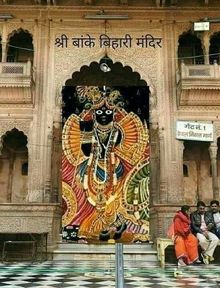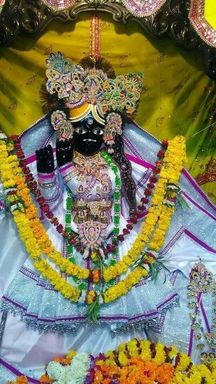Krishna is also called Banke Bihari. Kanha is usually called Shree Banke Bihari Ji, but why? This article explores the story of Krishna’s name, the Banke Bihari temple in Vrindavan and other information about Him.
Banke Bihari Temple is a popular destination. It was built by Swami Haridas in 1864 and is devoted to Lord Krishna.


The term ‘Banke’ in “Banke Bihari” suggests ‘bent at three places
The term ‘Banke’ in “Banke Bihari” suggests ‘bent at three places. The term ‘Bihari refers to “the Supreme Enjoyer”. Krishna is regarded as the supreme enjoyer and that’s why He is the benefactor of bliss and pleasure. One interpretation of “Banke Bihari” is that it actually stands for “Van Ke Vihari”, or “one who dwells in the jungle”, as He did during His childhood pastimes with the cowherds and gopis. Lord Banke Bihari is also known as Thakurji, the owner of everything. The black wooden idol of Banke Bihariji was brought from Nidhivan by Swami Haridas. The image inside the Shri Banke Bihari Mandir was granted to Swami Haridas by Shyama Shyam themselves. Submitting to the desire of devotees, Lord Banke Bihari appeared in person with his divine consort and left-back a black charming image before disappearing. The idol consists of Radha Krishna and its offerings have been merged into one on request of Swami Haridas so he could see both of them simultaneously. During this
Unlike other temples, this temple does not observe the Mangal Aarti. There are three sevas: Shringar, Rajbhog and Shayan. During Shringar, the lord is bathed, dressed and decorated with jewellery. In the forenoon, Thakurji is offered Rajbhog, which is a feast including the best delicacies to satisfy the taste buds of the child. The third seva is known as Shayan and in this service; Banke Bihari is made to sleep.

Another feature of this temple is that the deity is clothed and offered food at a different time of year based on the season. During the months of ‘Saawan’ (monsoon), it is decorated with flowers and lights. This decoration of the temple, called ‘Bangala’, suggests a bungalow of the Lord. The temple doesn’t have any bell or conch but has a sound that could disturb Bihariji.
Banke Bihari has magnetic appeal in his eyes and to prevent that, there’s a curtain on him every 1 minute. The charisma of the God if really strong and it is believed that if someone stares into them for a long time, their self-consciousness would go away.
The only thing that is common throughout the temple is the chant of ‘Radhe Radhe. The Lord loves the name of ‘Radha’ that is why the shrine always reverberates with the chant. The structure of the temple was influenced by Rajasthani architecture and hasn’t lost its charm. Thousands of devotees come to visit this sanctuary every day.
Janmashtami
Janmashtami is celebrated here with full gusto, and the whole temple is decorated with flowers and lights. There is no ‘darshan’ (divine view) of the deity on Janmashtami because the Lord is said to be in the womb of her mother. The ‘darshan’ is allowed only when it strikes 12 in the night on Janmashtami. For Sawan and Phagun, the altar of Bihariji as taken out of the main temple’s shrine so that devotees can get a divine view. Even in Phagun, Vrindavan maintains much celebration. On Holi, Banke Bihari plays Holi, and the town gets submerged in colours.
More places to visit –Places to visit in Barsana, Shri Ji Temple Barsana, Kirti Mandir Barsana , Prem Temple Vrindavan, Radha Raman Temple Vrindavan, Shri Krishan Janambhumi Mathura, Goverdhan Hill Mathura, Shani Dev Temple Mathura
